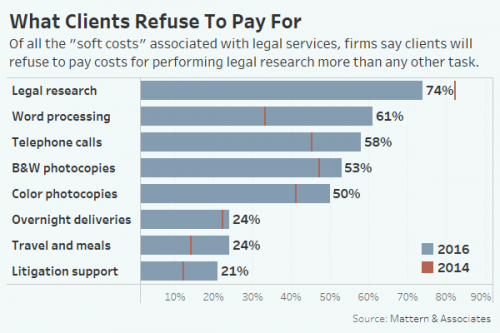
Why Law School Students Need Digital Competency
04/01/2019 By Bill4Time Staff

When it comes to technology, lawyers are risk-averse.
At least, that’s the stereotype trotted out by legal technologists. But is this actually true? Are lawyers this resistant to technology, innovation and growth?
Not at all.
The evidence shows lawyers and law firms are innovating. Slowly but surely, law firms all around the country are adapting to meet the demands of today’s modern client.
Here’s the problem.
Law schools aren’t moving in lockstep with firms
Today, clients are obsessed with value.
Law firms are expected to produce tangible results and outcomes for their clients. What’s worse, clients are no longer willing to pay for research costs, expenses and/or first-year/junior associates.
Firms are expected to do more with less.

A Mattern & Associates study found “firms only see a return of a quarter of all costs associated with work done on a particular matter.”
What does this mean?
- Clients themselves are under intense pressure to produce results
- Clients pressure law firms to produce results, focusing exclusively on value.
- Both clients and law firms expect more immediate value from junior associates
A reasonable expectation, right?
This isn’t what’s happening.
Law schools: A safe haven for Luddites
When it comes to technology, the majority of law school students are sophisticated users of social media and texting.
And that’s about it.
Dig a little deeper you begin to realize this is a complete disaster. The average (majority) of students leave law school with $100,000 to $200,000 of student loan debt. Law school is a whopping 5.82 times more expensive than it was in 1985. You can view the debt rankings by school here.

Well it’s not so bad because many first-year associates are paid well, right? Sure, the lucky ones who are hired are sometimes paid well. Are most of these students getting jobs?
Not so much.
The ABA Journal released a report showing that less than half of graduates had jobs before graduation. The evidence shows a large segment of the law school population doesn’t fare any better post-graduation.
This is why law school students need digital competency
Law firms, like their clients, are under a significant amount of pressure to perform. They need new associates, law school graduates, who can hit the ground running. These are the graduates who consistently win excellent positions with well-paying firms.
Law schools are struggling to deliver.
New graduates are clueless about the kind of technology they’ll use in a firm.
They’re unfamiliar with word processing, working with PDFs and manipulating spreadsheets. They’re also unfamiliar with the ins and outs of practice management software, automated document assembly, legal project management document and knowledge management.
Most new graduates are unaware of the tools they’ll need to function in their day-to-day life as a lawyer. Most graduates are lost – but it also isn’t their fault.
The good news? Change is coming – law school student digital competency is on the horizon
Law schools are shaking up their curriculum, prioritizing digital competency ensuring graduates are better prepared for life after the bar.
Change is slow.
Law school students can improve their postgraduate prospects by focusing on their core competencies. The skills and technology needed in their practice area/firm.
Are lawyers risk-averse?
Absolutely. As far as critical thinking goes, lawyers are exceptional. Law firms aren’t resisting technology, they’re embracing it, albeit slowly. Firms all around the country are adapting to meet the high-pressure demands of today’s modern client.
Law school students don’t have to wait to become digitally competent.
An emphasis on value in law schools means graduates are prepared to produce said value. The law school environment is competitive. Today’s graduates are fighting for a seat at the table. With the right education and an emphasis on digital competency, every graduate can win.




